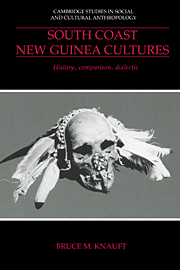Book contents
- Frontmatter
- Contents
- List of figures
- List of tables
- Acknowledgments
- 1 Language-culture areas of south coast New Guinea
- Part 1 Grounding
- Part 2 Critique
- Part 3 Reconfiguration
- 7 Theoretical reconfiguration
- 8 Marind-anim
- 9 Symbolic and sociopolitical permutations
- 10 Regional characteristics and comparisons
- Appendix: evidence concerning Asmat homosexuality
- Notes
- List of references
- Index
- Cambridge Studies in Social and Cultural Anthropology
10 - Regional characteristics and comparisons
from Part 3 - Reconfiguration
Published online by Cambridge University Press: 04 December 2009
- Frontmatter
- Contents
- List of figures
- List of tables
- Acknowledgments
- 1 Language-culture areas of south coast New Guinea
- Part 1 Grounding
- Part 2 Critique
- Part 3 Reconfiguration
- 7 Theoretical reconfiguration
- 8 Marind-anim
- 9 Symbolic and sociopolitical permutations
- 10 Regional characteristics and comparisons
- Appendix: evidence concerning Asmat homosexuality
- Notes
- List of references
- Index
- Cambridge Studies in Social and Cultural Anthropology
Summary
Distinctive cultural orientations can be identified at regional as well as local levels and then analyzed in relation to existential conditions. The analysis is similar to that undertaken in the previous chapter; its scale is increased.
As a region, nonAustronesian south coast New Guinea placed particular cultural emphasis on the sexual creation of fertility and the violent taking of life-force through headhunting. These themes were manifested as part of larger culturally constituted linkages between reproduction, growth, and death – an encompassing fertility cycle. The south coast thus provided a distinctive regional permutation on beliefs and practices found elsewhere in Melanesia that linked cultural fertility through various dimensions of sexuality, bodily substance, growth, labor productivity, social exchange, depletion, and death (Knauft 1989a). Within this cycle, the south coast region culturally accentuated (a) the creation of life-power through ritual heterosexuality and sometimes also homosexuality, and (b) the taking of life-force by severing enemy heads, as if in military copulation.
The close relationship between these twin emphases was epitomized in the cry of the Trans-Fly raider as he struck his victim for decapitation with a headhunting club: “Tokujenjeni is copulating with you!” – tokujenjeni was the primal phallic bullroarer obtained by the Originator from his wife's vagina (Williams 1936:182f.).
- Type
- Chapter
- Information
- South Coast New Guinea CulturesHistory, Comparison, Dialectic, pp. 210 - 227Publisher: Cambridge University PressPrint publication year: 1993



